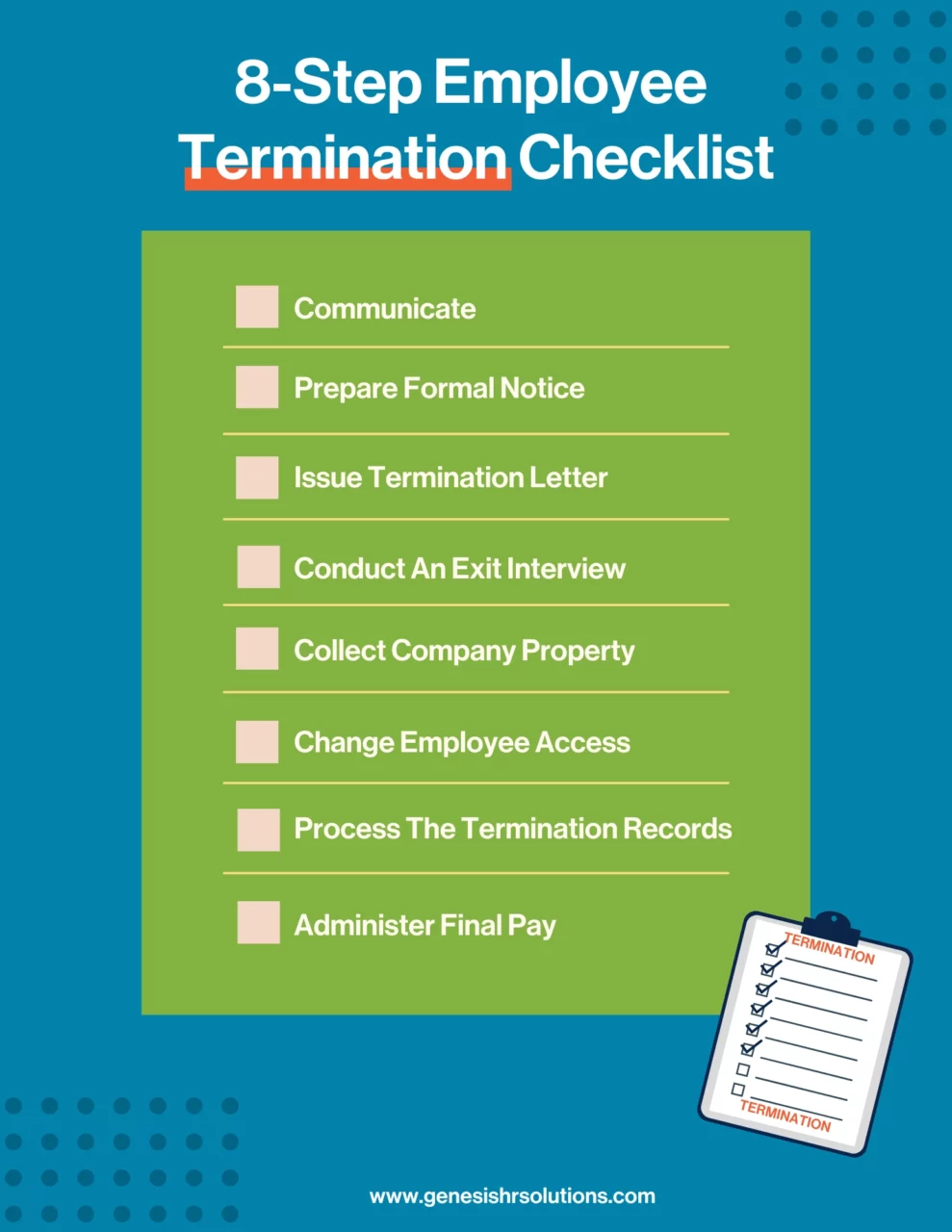Whether due to company restructuring, performance issues, or voluntary resignation, employee exits tend to be unforeseen events that can leave employers and their teams scrambling.
HR can pave the way for a smoother exit with a little forethought—and the creation of an employee termination checklist. A checklist is one of the best tools employers can use to ensure they follow all the necessary steps during the termination process, verifying that the termination complies with all business and legal requirements. Another bonus: A well-thought out checklist can also help you prioritize the employee experience up until their very last day on the job.
A well-thought out employee termination checklist can help you prioritize the employee experience up until their very last day on the job. Share on XBelow is a sample employee termination checklist you can use as a guide. We recommend tailoring it to meet your own organization’s unique requirements.
Termination checklists aren’t the only thing HR teams should have in their toolkit. Download your free employee onboarding checklist here to streamline your hiring process.
The 8-Step Employee Termination Checklist
While it’s common that at least one party—either the employee or employer—won’t be expecting the termination, employers must still diligently follow a set procedure to make sure both sides walk away feeling like the process was fair, efficient, and well-executed. Below is an eight-step checklist to help you and your HR team manage the termination process effectively:

1. Communicate
The importance of thorough and timely communication throughout the entire termination process cannot be overstated. But unfortunately, many businesses don’t prioritize this as the number one objective on their list.
Communicate with leadership, HR, payroll, and IT teams to ensure that all termination processes are handled correctly and in the necessary order. Later on, all staff members or customers, where applicable, should be informed about the change and how they may also be affected.
Of course, keep in mind that it’s essential to communicate all details to the employee during every step of the process. They’ll feel valued and respected as a result, and also have a clear understanding of the situation taking place.
2. Prepare Formal Notice
Depending on the type of termination taking place—voluntary or involuntary—formal documentation provided by the employee, or you as the employer, is necessary.
In the event of a voluntary termination, a verbal notice given to you on its own is not sufficient. Voluntary employment terminations should be followed up with a formal resignation letter from the employee that states their intent to leave their position and the date they intend to do so. While an employee might request to end their employment on a specific date, you may decide to end the relationship immediately. However, they may be eligible to receive unemployment insurance payments for the days between their notice and their termination.
For an involuntary termination, employers are required to provide a formal document that outlines the reason for the employee’s dismissal. This document should include any warnings or disciplinary actions taken before the termination, if applicable.
3. Issue Termination Letter
Drafting a formal termination letter is helpful to you and the employee when it comes to identifying all of the necessary steps to be taken when concluding the employment relationship. This document should include all the details surrounding the employee’s final salary payment, benefits termination date, and other information related to ending their employment.
Termination letters should include a section at the end outlining any legal or contractual obligations, such as non-disclosure or non-compete agreements, to avoid any post-employment disputes. This final paperwork should also clearly inform the employee about what happens to their 401(k) and benefits plan coverage, including their options for continuing coverage through COBRA or other government programs.
Severance agreements should also be included in the termination documents. The letter should clearly explain any terms and conditions of the severance agreement, including any payment schedule, outplacement services, and other benefits that may have been negotiated.
4. Conduct An Exit Interview
A commonly overlooked yet essential step on an employee termination checklist is conducting an exit interview. Exit interviews provide a unique opportunity to gain insight into your employees’ experiences with the company and what can be improved upon in the future.
Exit interviews typically consist of a series of questions that the employee is asked to answer. These interviews are ideally handled face-to-face; however, they can also be conducted over the phone or through a survey. During these interviews, ask questions about the employee’s experience with their coworkers, job satisfaction, and any suggestions for making the workplace more productive or enjoyable.
The most important part, though, is the follow-through—actually using the information collected during this process to make improvements and implement changes. This will set you up for success when it comes to future hiring, retention, and overall employee satisfaction.
5. Collect Company Property
Plan to collect any company property the employee may possess before they leave, such as laptop computers, phones, access cards, or files containing confidential information. Depending on the size of your organization and the industry you work in, you may need to ensure that proper security protocols are followed when returning company property, which (hopefully!) have already been laid out in the employee handbook.
For employees that operated remotely or worked outside of the office, it’s best practice to establish a timeline for returning company property and, if applicable, provide prepaid shipping boxes and labels to streamline the process.
6. Change Employee Access
Once you have collected all the necessary company property, it is important to confirm that the employee can no longer access any company assets or resources. This includes changing passwords for any accounts associated with the employee and deactivating access cards, email accounts, and other login credentials that may be linked to their name.
The timing and manner in which you deactivate any access and logins should be respectful to the employee. IT teams should be informed ahead of time when to begin the process of revoking access. In certain cases, the process may have to be expedited if the employee is involuntarily terminated to minimize the risk of data theft or other malicious activity.
Also remember that employees may need access to their computers or business accounts to remove any personal data that may have been stored on their work devices. Providing this type of access is a courtesy and should be done per any privacy policies already in place.
7. Process The Termination Records
Execute any backend processes associated with the employee’s termination. This includes removing them from the payroll and benefits they may be enrolled in, as well as organizing and filing all of their digital and physical employee records appropriately.
Depending on the size of your organization and the industry you work in, you may need to process additional records or file certain reports. This will vary from company to company, so ensure you’re familiar with any regulations your organization needs to follow when processing employee terminations. You may be required to keep certain documents related to terminated employees for up to seven years.
8. Administer Final Pay
State laws dictate the time frame of when final pay must be administered after an employee’s termination; however, most states require that it be paid anywhere between one and three days after separation. In certain states, the final payment is due the same day of an involuntary termination, while in other situations, it may be due on the next regularly scheduled pay period.
Care should be taken to ensure that the employee’s final pay includes not just final wages but also any commissions or bonuses owed, accrued paid time off (PTO), and any reimbursements still owing.
Parting Ways On Good Terms
Regardless of the reason, it’s important to terminate an employee with care and respect to preserve the company’s reputation and maintain good relationships with former employees.
Former employees may interact with customers, prospective employers, and other stakeholders over time or even become a customer or partner of the company in the future. Maintaining goodwill with past employees and ensuring their offboarding process is as seamless as possible during their transition helps build a strong company culture and holds the trust of the individual and anyone still connected to the organization.
Regardless of the reason, it’s important to terminate an employee with care and respect to preserve the company's reputation and maintain good relationships with former employees. Share on XKeep this checklist for terminating employees in your HR toolkit so you’re always ready to handle staff terminations as professionally and efficiently as possible, regardless of the situation.
Identifying and tackling all aspects of the termination process is time-consuming and requires specialized knowledge of employee offboarding best practices. GenesisHR supports companies in filling the necessary skill and bandwidth gaps across all areas of HR, including employee terminations. Whether you need advice on how to manage the process or a dedicated PEO to handle all onboarding and offboarding procedures, we’re here to help. Let us know what you need covered—contact us today!





